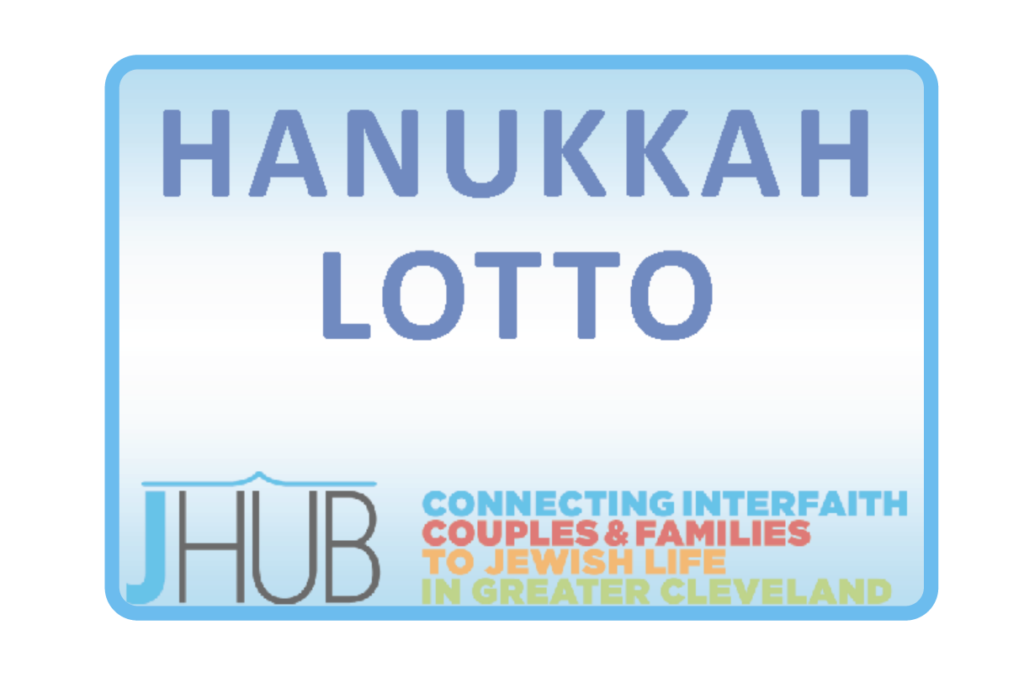Hanukkah-in-a-digital-box
Hanukkah in a DIGITAL Box!
Table Of Contents
Chag Urim Sameach –
Happy Festival of Lights!
This season shines bright! Hanukkah, also known as the Jewish Festival of Lights, is right around the corner. Hanukkah is a special time to gather with family and friends to celebrate the rededication of the Holy Temple in Jerusalem. Each of the eight days of celebration is an opportunity to connect over rich traditions and food, spend quality time with loved ones, and bring joy to others!


The History of Hanukkah
Hanukkah is an eight-day holiday that begins on the 25th day of Kislev, the ninth month of the Jewish calendar. This year it begins on Dec. 18th, but it is always celebrated beginning in late November or December, based on the Hebrew calendar.
Interestingly, the story of Hanukkah that we tell today is a mash-up of two tales. The Book of Maccabees I, written in the 2nd century BCE, tells the story of military might and Israelite (ancient Jewish) self-determination. The Maccabees rededicated the Temple in Jerusalem after it had been defiled by Greek rule (Maccabees I 4:57):
“Yehudah and his brethren with the whole congregation of Israel ordained to celebrate the days of the dedication of the altar celebrated in their season from year to year for a period of eight days, from the five and twentieth day of the month Kislev, with joy and gladness.”
According to the book of Maccabees, we celebrate this holiday for eight days to emulate the fall holiday of Sukkot, which was the most recent pilgrimage holiday they were unable to commemorate. However, within a few centuries, some of the first Rabbis turned this story of religious reclamation into a theological miracle. In the Babylonian Talmud, compiled between the 3rd and 5th centuries CE, we find their understanding of this holiday to focus on the story of the oil that was necessary to light the Temple menorah, a seven-branched candelabrum (Shabbat 21b):
“What is Hanukkah? Our Sages taught: On the 25th of Kislev - the days of Hanukkah, they are eight, not to eulogize on them and not to fast on them. When the Greeks entered the Temple, they polluted all the oils in the Temple, and when the [Maccabees] overcame and defeated them, they checked and they found but one vessel of oil that was set in place with the seal of the High Priest, but there was in it only [enough] to light a single day. A miracle was done with it, and they lit from it for eight days. The following year [the Sages] fixed those [days], making them holidays for praise and thanksgiving.”
Throughout Jewish history, Hanukkah has remained a minor holiday on the Jewish calendar. The classic Hanukkah game, spinning the dreidel, was developed as a front for Jewish gatherings on this day in times when being Jewish was forbidden or unsafe. An assortment of fried foods were also adopted throughout the Jewish world to honor the miracle of the oil.In the past two centuries, Hanukkah’s rise to prominence has mirrored other winter holidays emphasizing spending time with family and friends . Some people give gifts or make donations throughout the holiday to spread joy during the celebration.
When we light our Hanukkah menorah to celebrate, it is both an expression of pride in our Jewish identity and an acknowledgment that great things can happen to us when we least expect it.
Hanukkah Blessings
Blessing Over the Hanukkah Candles
To be said prior to lighting the candles.
,בָּרוּךְ אַתָּה יְיָ, אֱלהֵֹינוּ מֶלֶךְ הָעוֹלָם, אֲשֶׁר קִדְּשָׁנוּ בְּמִצְוֹתָיו
.וְצִוָּנוּ לְהַדְלִיק נֵר שֶׁל חֲנוּכָּה
Barukh atah Adonai, Eloheinu Melekh ha’olam, asher kid’shanu b’mitzvotav, v’tzivanu l’hadlik ner shel Hanukkah.
Blessed are You Adonai our God, Ruler of the universe, who has made us holy through God’s commandments, and commands us to light the Hanukkah candles.
Blessing for Miracles
Recite immediately following the first blessing, prior to lighting.
,בָּרוּךְ אַתָּה יְיָ, אֱלהֵֹינוּ מֶלֶךְ הָעוֹלָם
.שֶׁעָשָׂה נִסִּים לַאֲבוֹתֵינוּ בַּיָּמִים הָהֵם בַּזְמַן הַזֶּה
Barukh atah Adonai, Eloheinu Melekh ha’olam, She’ahsa neesim la’avotaynu bayamim haheim baz’man hazeh.
Blessed are You Adonai our God, Ruler of the universe, who performed wonders for our ancestors in history at this very time of year.
Blessing for Special Occasions
Recite following the Blessing for Miracles only on the first night of Hanukkah.
,בָּרוּךְ אַתָּה יְיָ, אֱלהֵֹינוּ מֶלֶךְ הָעוֹלָם
.שֶׁהֶחֱיָנוּ וְקִיְּמָנוּ וְהִגִּיעָנוּ לַזְּמַן הַזֶּה
Barukh atah Adonai, Eloheinu Melekh ha’olam, shehekheyanu v’kiy’manu v’higiyanu laz’man hazeh.
Blessed are You Adonai our God, Ruler of the universe, who gave us life, sustains us, and enabled us to reach this season.
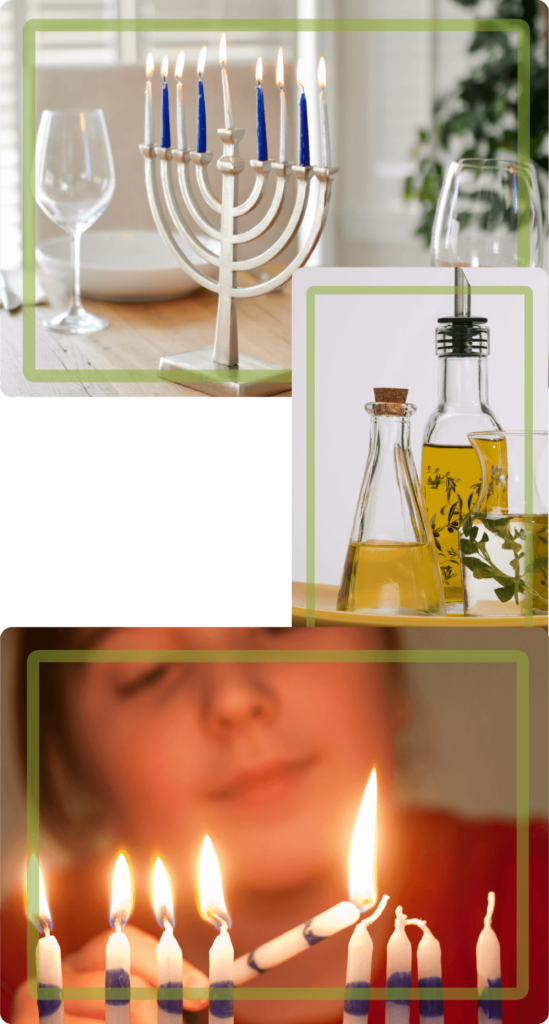
Hanukkah Recipes
Add these delicious dishes from all over the world to your holiday spread this year!
Mizrachi
(Jewish ancestry from the Middle East and North Africa)
Zalabia
A Middle Eastern deep-fried pastry better known as funnel cake.
Other Names– Arabic: zalabiya, zelabiya, zelebi; Farsi: zoolbia, zoolbiya, zolubiya; Indian: jalebi; Iraq: zengoula, zingzoola; Kurdistan: zulubiye; Syria: zinghol, zingol; Turkey: zulbiye.
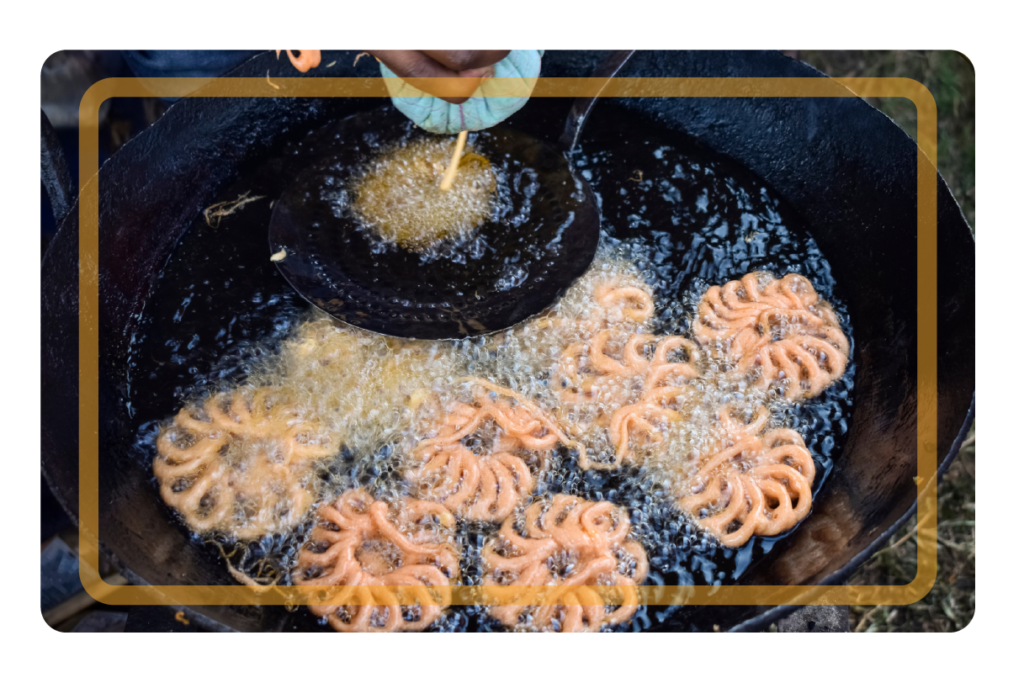
Ingredients
Syrup
- 1 cup water
- 1/2 cup sugar
- 1 tsp lemon juice
- 1 tsp rose water (you can skip the rosewater; however, the rosewater gives it the special middle eastern flavor)
Batter
- 2 cups flour
- 2 Tbsp rice flour/ 1 Tbsp cornstarch
- 1 tsp baking powder
- 1 cup warm water
- 1/2 cup plain yogurt
- Oil for frying
Cooking Equipment
Syrup
- Saucepan
- Measuring cups and spoons
- Mixing spoon
Batter
- 1 Gallon Ziploc bag
- Measuring cups and spoons
- Scissors
- Skillet
- Spatula
- Tongs
Instructions
Syrup
- Mix sugar, water, lemon juice, and rose water in a small saucepan. Stir over medium heat until sugar dissolves.
- Bring to a slow boil for approximately ten minutes or until it starts to have a syrupy consistency. Set aside.
Batter
- In the gallon Ziploc bag mix flour, rice flour/cornstarch and baking powder.
- Once dry ingredients are mixed, add the wet ingredients. Close the bag and use your hands to knead/mix the ingredients. The consistency of the batter should be like a thick pancake batter. If it is too thick, add a Tbsp more of water at a time. Note– make sure there is not too much air in the bag when trying to mix.
- While mixing, you can heat your oil to 375°.
- Snip one end of your bag and use it as a piping bag to squeeze the batter into the oil. Zalabia is traditionally piped out into spirals but you can make any shape you desire.
- Fry on both sides until golden brown.
- Once fried, dip the spirals into the syrup, coating both sides.
- Enjoy your Hanukkah treat!
Hanukkah Sufganiyot (Doughnuts) In a Bag
Sufganiyot came from the amalgamation of Central Europe and Middle Eastern traditions. Today it is a staple of Hanukkah in Israel, with people consuming more than 18 million sufganiyot in the weeks around the holiday.
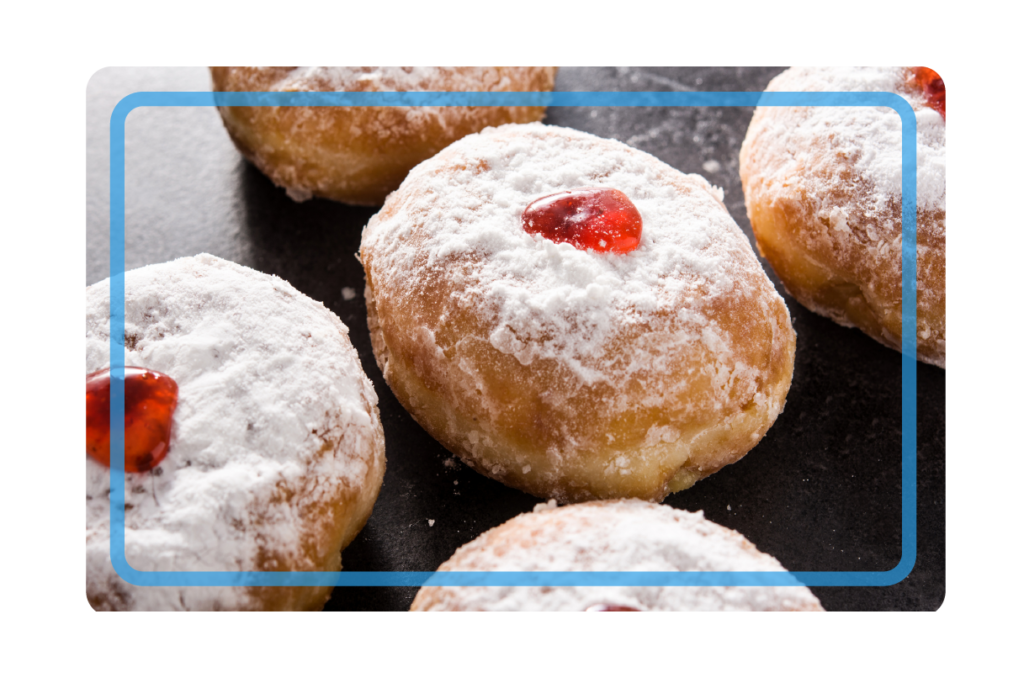
Ingredients
- 1 package yeast
- 1 cup warm water
- 3 Tbsp sugar
- 2 tsp. vanilla
- 1/2 tsp. Salt
- 1 1/2 Tbsp oil + more for frying
- 1 egg
- 3 cups flour
- Choice of filling
Instructions
- In a gallon-sized plastic bag, add the yeast, warm water, sugar, vanilla, salt, oil, egg, and flour.
- Zip bag and mix ingredients well.
- Let the dough rise. It should double in size.
Option 1- Place the bag in a bowl of very warm water for 1 hour.
Option 2– Place the bag in the refrigerator until ready to use.
If the dough has not risen, place in a bowl of warm water for 1 hour. If it has risen already, go to the next step.
- Remove the dough from the bag onto a floured surface. The dough should be sticky, make sure both sides of the dough are floured, so it doesn’t stick to the surface. Roll out the dough to 1/2 inch thickness.
- With a cookie cutter or drinking glass, cut 2 inch circles in the dough. When you have scraps of dough, roll it out again and cut more circles.
- Cover with a towel for 30 minutes.
- Fill a pan with 2 inches of oil. Heat the oil to 350F. If you don’t have a thermometer, the correct temperature will be around medium. You will know if it is correct when you add the sufganiyot. The oil should bubble around the sufganiyot, but not a ton of bubbles. Fry for about 1 minute on each side until golden
Filling The Sufganiyot
- Use a knife to stick a hole in the side of the doughnut.
- With your choice of filling: jelly, frosting, caramel, etc., fill a sandwich-size plastic bag in one corner, then cut the end off and stick the bag in the hole you made and squeeze the filling in.
Ashkenazi
(Jewish ancestry from Eastern Europe and Russia)
Latkes
Latke, meaning “little oily,” is a pancake. The predominant type is made from grated potatoes.
Origin: Eastern Europe
Latkes derive originally from Italian ricotta pancakes. Being fried and made with dairy made them suitable for Hanukkah. The Germans began using potatoes for pancakes in the late 18th century, after which it evolved into the classic recipe of Eastern Europe. ( The Encyclopedia of Jewish Food.)
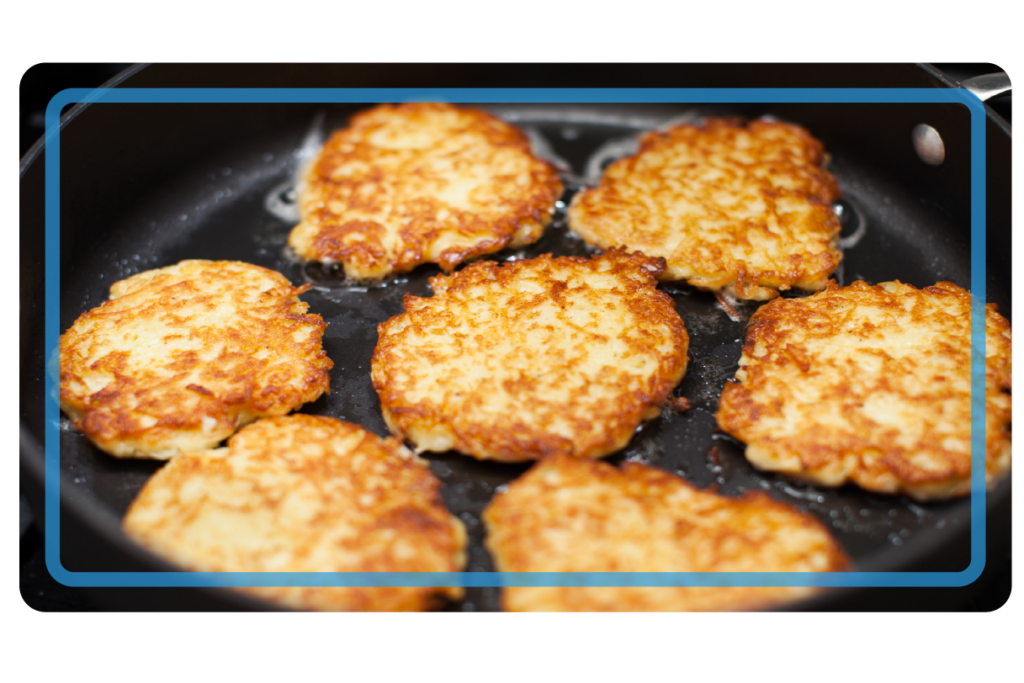
Ashkenazic Cheese Pancakes (Kaese Latkes/ Levivot Gevinah)
This recipe, from the Encyclopedia of Jewish Food, makes about 26 3-inch pancakes.
Ingredients
- 2 cups farmers cheese, pot cheese, or drained ricotta cheese
- 4 large eggs
- ¾ cup flour
- 2 Tablespoons sugar or honey
- ½ teaspoon vanilla extract
- ½ teaspoon salt
- Vegetable oil or butter for frying
Instructions
- In a large bowl, beat together the cheese, eggs, flour, sugar, vanilla and salt until well combined.
- In a large skillet or griddle, heat a thin layer of oil over medium heat.
- Drop the batter by heaping tablespoons and fry until the top set and the bottom is lightly browned, about 3 minutes. Turn and fry until golden for about 2 minutes. Serve with sour cream, yogurt, maple syrup, jam, cinnamon sugar or fresh fruit.
Potato Latkes
Ingredients
- 1 ½ pounds baking potatoes (3 to 4 potatoes)
- ½ medium yellow onion, peeled and quartered
- 1 large egg
- 2 tablespoons matzah meal
- 1 teaspoon kosher salt
- ⅛ teaspoon freshly ground black pepper
- 1 cup canola oil or chicken schmaltz, or a combination of both for frying
- Applesauce and sour cream, for serving
Instructions
- Grate potatoes and onions in a food processor.
- Squeeze as much liquid as you can out of the grated potatoes and onions into a bowl.
- Let the liquid sit for a few minutes to allow the potato starch to settle and then pour off the liquid leaving the potato starch.
- Mix the potatoes, onions, egg, matzah meal, salt, pepper with the potato starch.
- Place ¼ inch of oil in a skillet and heat over medium-high heat.
- Scoop ¼ cup of latke mixture and flatten with fingers and place in hot oil.
- Fry until golden brown 4-5 minutes per side, adjusting heat if necessary.
- Cool the latkes on a paper towel-lined plate.
- Serve with applesauce and sour cream.
Sephardi
(Jewish ancestry from the Iberian Peninsula)
Bimuelo
Bimuelo refers to a variety of small fried foods, sweet or savory, including doughnuts, fritters and pancakes.
Origin: Spain
Other names: Arabic: awamee; Greek: loukoumas; Romaniote Greeks: zvingous; Ladino: bimuelo, bimwelo, bumwelo, burmuelo; Spanish: bunuelo.
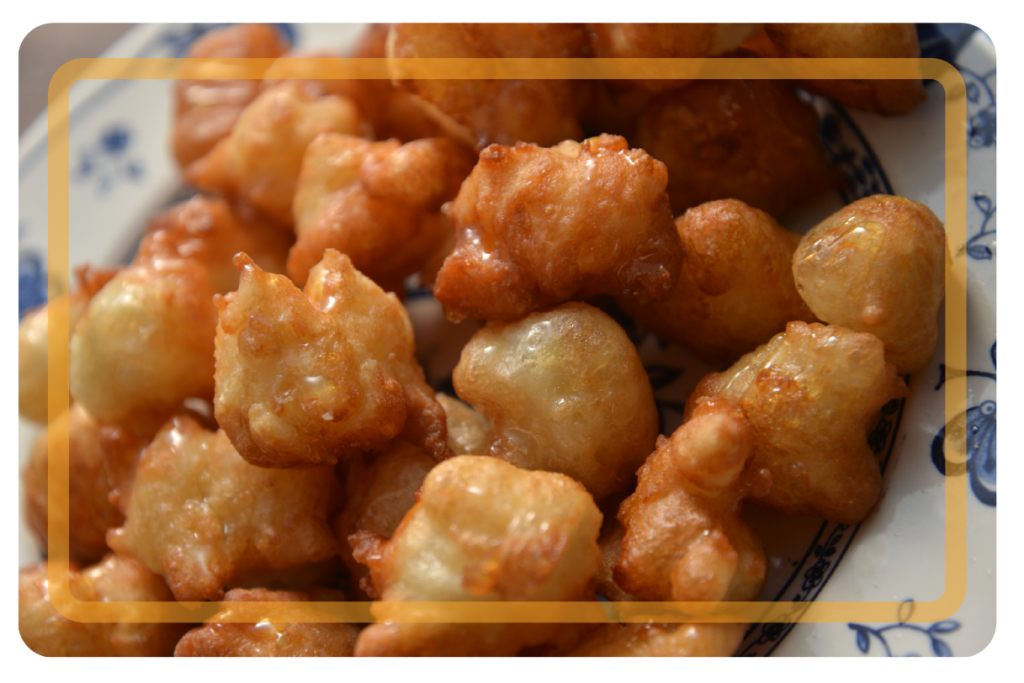
Ingredients
- 1 ½ cups flour
- 1 teaspoon baking powder
- A pinch of salt
- 1 egg
- 1 cup milk
- Vegetable oil for frying
- Optional- honey, maple syrup, powdered sugar for topping
Instructions
- Mix all the dry ingredients
- Add the egg, milk and stir.
- In a frying pan heat up about 2 inches of oil to about 365 degrees.
- Drop the batter by tablespoons into the oil and fry for about 2-3 minutes until golden brown.
- Place finished Bimuelo on a paper towel-lined plate to cool and allow excess oil to drain.
- Top with honey, maple syrup or powdered sugar.
Directions:
- Before playing, distribute a game board to each player. Place the picture cards face down and in reach of all of the players.
- Player one chooses a card from the pile, identifies it and attempts to match it to the same symbol on their board.
- Players take turns moving clockwise, choosing cards, identifying, and matching symbols to their lotto boards.
- You may choose one of four ways to play, ending either when a player covers a row, a column, all four corners, or the entire board.
Directions:
- To start, each player will need 25-30 bingo markers. You can use marshmallows, chocolate chips, cereal, or any other creative items you can think of.
- The designated bingo caller will then call out random words from the bingo cards.
- Whenever players see or hear a word on their bingo card, they cover that word with their marker.
- When they get a bingo (by having 5 in a row either vertically, horizontally or diagonally), they call out BINGO and they are the winner!
You can come up with small prizes for the winners or just let them eat their bingo markers (the kids love that!).
Dreidel
The game of dreidel is played using a toy of the same name. On each side of the dreidel are the Hebrew letters נ ג ה ש. These letters form an acronym for the phrase Nes Gadol Haya Sham which means “A Great Miracle Happened There” (in Jerusalem) and references the miracle of the oil that occurred after the Maccabees reclaimed the Temple.
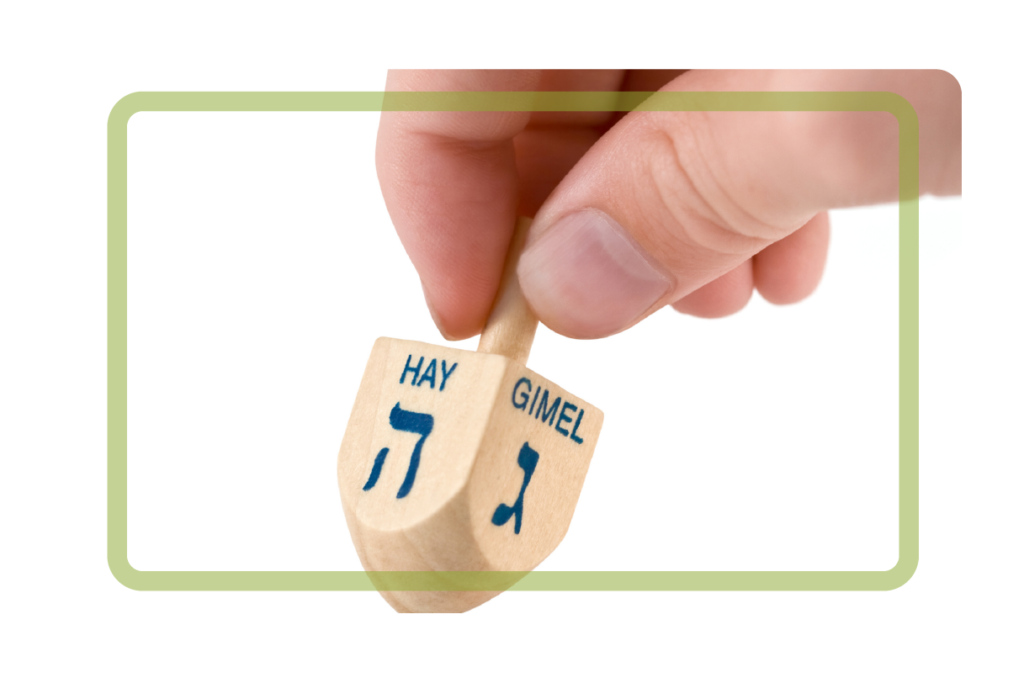
Directions:
- To play the game, each player needs the same number of coins or candy, and play begins with every player putting two pieces in the center.
- Players take turns spinning the dreidel. If it lands on ש, the player puts in another piece. If it lands on ה, the player takes half the pieces from the center. If it lands on נ, the player does nothing. If it lands on ג, the player wins by taking all the pieces from the center.
- After a win, play continues with everyone placing two more pieces in the center.
Hanukkah Crafts
There is nothing quite like a handmade holiday decoration! Learn how you and your loved ones can make your own menorah or dreidel for this year’s festivities.
Keep the Party Rolling
Many families look for alternative ways to celebrate, other than giving gifts for all eight nights to focus on the joy of the holiday. Here are some suggestions:
First Night: Gift Night – Celebrate by giving small gifts. Additionally, have every family member choose another family member’s name out of a hat. Family members can then make (rather than purchase) a gift for the selected relative to be given later during the holiday.
Second Night: Craft Night – Make Hanukkah-related crafts or decorations to display in your home. These can be Happy Hanukkah signs, hand-drawn pictures of dreidels, a creative menorah and anything else that comes to mind.
Third Night: Family Game Night – Every family member chooses a game for the family to play.
Fourth Night: Book Night – Give books as gifts or borrow Hanukkah-themed books from the library and read them together.
Fifth Night: Dessert Night – Celebrate with food! Make or buy jelly doughnuts, cookies shaped like menorahs or dreidels, or whatever your family enjoys.
Sixth Night: Family Outing – Choose something fun to do as a family, such as going to the movies or a favorite restaurant.
Seventh Night: Give a Gift – Present the gifts you made from the first night.
Eighth Night: Tzedakah Night – Tzedakah is Hebrew for “justice,” so this is a night to do something to make the world a better place by helping those in need. This can take many forms, including charitable donations, working on behalf of social causes etc.
Our Favorite Hanukkah Books
Adults:

The Tapestry of Jewish Time: A Spiritual Guide to Holidays and Life-Cycle Events
by Rabbi Nina Beth Cardin
A guide to the Jewish year, including a chapter on Hanukkah, that shares its history, meaning, traditions and modern customs for celebration.
Children:

The Latke Who Couldn’t Stop Screaming: A Christmas Story
by Lemony Snicket
A cute story of a latke who is perplexed by his Christmas encounters and is seeking to be accepted for who and what he is. Good content on the meaning of Hanukkah. And it ends with a lighthearted twist.

Light the Lights! A Story About Celebrating Hanukkah and Christmas
by Margaret Moorman
A warm story about Emma and her family who celebrate both Hanukkah and Christmas.

Elijah’s Angel: A Story for Chanukah and Christmas
by Michael J. Rosen
A Jewish family befriends a Christian man. They learn to appreciate each other’s traditions and values. They do not adopt the other’s beliefs, but respect them and their practices.

Hanukkah Moon
by Deborah da Costa and Gosia Mosz
A Jewish family learns new Hanukkah customs and rituals from their Mexican aunt. They are now excited to celebrate with her again in the year to come.

The Winter Witch
by Clay Bonnyman Evans
A child proclaims to hate Christmas now that his father has married a Jewish woman and she and her child are Jewish. He thinks they will dampen his Christmas celebration, until the “Winter Witch” enlightens him and he learns to appreciate the two winter festivals.

Queen of the Hanukkah Dosas
by Pamela Ehrenberg
In this children’s picture book, little Sadie and her multicultural family — her mom is Indian and her dad is Jewish — celebrate Hanukkah while mixing in some of her mother’s Indian traditions, like eating dosas.

Herschel and the Hanukkah Goblins
by Eric Kimmel
On the first night of Hanukkah, a weary traveler named Hershel of Ostropol eagerly approaches a village, where plenty of latkes and merriment should warm him. But when he arrives not a single candle is lit. A band of frightful goblins has taken over the synagogue, and the villagers cannot celebrate at all! Hershel vows to help them. But can one man alone stand up to the goblins, save Hanukkah, and live to tell the tale?

The Spotted Pony: A collection of Hanukkah Stories
retold by Eric Kimmel
A different story for each night of the holiday.
Glossary of Hanukkah Terms
Happy holiday!
Happy Festival of Lights
The Yiddish name for both the game and the spinning top used in this Hanukkah game. (see nes gadol haya sham for more information).
It’s customary to eat fried foods, such as potato pancakes (latkes) or doughnuts (sufganiyot), to commemorate the miracle of the oil found in the Temple. According to legend, when the Maccabees reclaimed the Temple, they found a single jar of oil to light the ner tamid (eternal light), only enough to keep it lit for one day. Miraculously, the oil burned for eight days (hence, the eight candles plus the helper candle).
A Yiddish word that means money. Chocolate coins called gelt are often given as gifts to celebrate the holiday.
Happy Hanukkah
Hanukkah menorah (see menorah)
Potato pancakes, a customary food often made by people of Ashkenazi descent (ancestry from Eastern Europe and Russia)
The name of the family that are heroes in the Hanukkah story. While not a part of the Jewish Bible, their story is preserved in the Book of Maccabees found in the Apocrypha. The word Maccabee means hammer in Hebrew and refers to Judah Maccabee as the strong leader who led the Jews to victory over the Syrian-Greeks and reclaimed the holy Temple. Another belief holds that Maccabee is an acronym for “Who is like You, O God?” which is part of the Jewish liturgy that praises God for creating miracles.
A candelabrum. A menorah typically holds 7 candles, but for Hanukkah, a special nine-branched candelabrum, also known as a hanukkiah, is used. The proper way to light the menorah is to add one candle each night in the following order: On the first night, place one candle in the far right holder and light it, using the helper candle. On the second night, add another candle to the immediate left of the first candle and light that first, followed by the original candle. Follow that pattern of adding from right to left, but lighting from left to right, until all eight candles are burning on the final night.
The Hebrew words represented on the dreidel by the letters נ ג ה ש . These letters form an acronym for the phrase Nes Gadol Haya Sham which means “A Great Miracle Happened There” (in Jerusalem) and references the miracle of the oil that occurred after the Maccabees reclaimed the Temple. Dreidels made in Israel use the letters נ ג ה פ, an acronym for Nes Gadol Haya Po, “A Great Miracle Happened Here.”
Literally “Advertising the miracle,” pirsum hanes is the act of sharing the miracle of the light with the rest of the world. This is why some people leave their hanukkiah lit in a window (safely away from flammable curtains, of course) or even outside using a special cover for your menorah. This is a physical act of bringing light into darkness.
The helper candle used to light the other candles. It is usually set apart in some way from the other candles (e.g., higher than the others or set in the middle)
Doughnuts, a customary food often made for Hanukkah in Israel.
The Hebrew word for dreidel (see dreidel).
Join jHUB!
We are excited to see how you incorporate these recipes, activities, and more into your Hanukkah celebrations this year!
Share with us on:
Facebook: https://www.facebook.com/jHUBCle
Instagram: https://www.instagram.com/jhubcle/
Twitter: https://twitter.com/jhubcle/
Pinterest: https://www.pinterest.com/jhubcle/
Looking for More Resources & Information on Upcoming jHUB Events?
Head to our website at jHUBCLE.org and join our email list.
Wishing you a joyous Hanukkah! We look forward to connecting with you.
